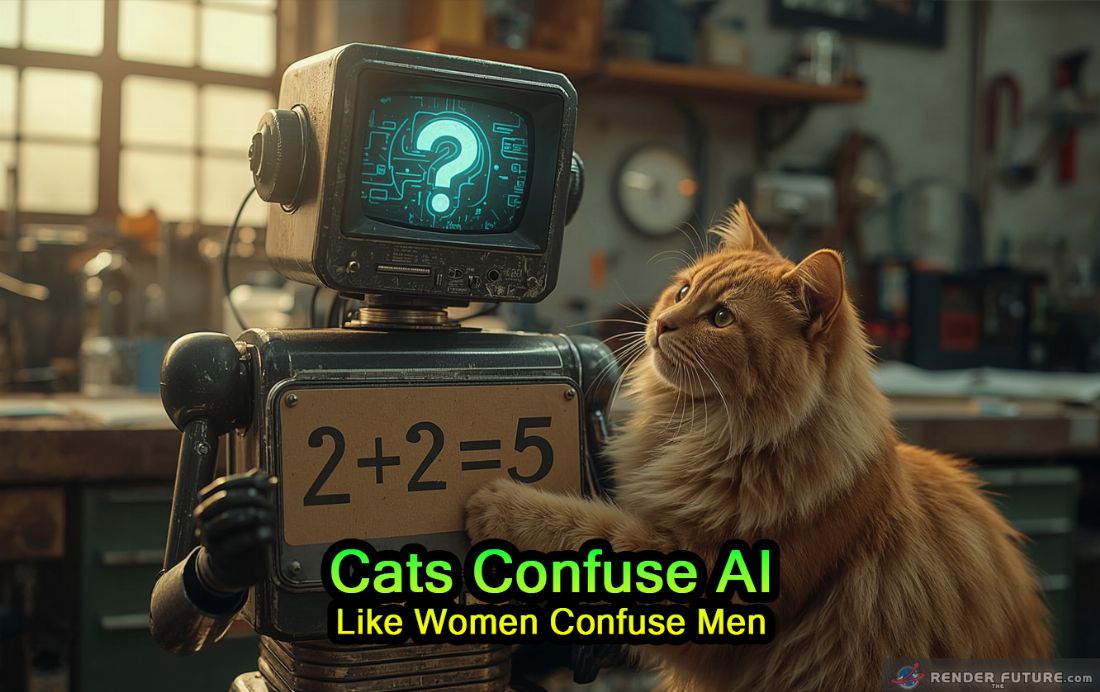Cats Confuse AI Like Women Confuse Men
The Unpredictability Effect
The Understanding Paradox
Just as men sometimes struggle to interpret women’s communication, advanced AI systems now show a similar blind spot – but with cats. New research reveals that inserting random cat facts (“Cats sleep 15 hours daily”) into math problems triples error rates in top reasoning AIs.
These “CatAttacks” work because:
- AI gets distracted by unexpected content
- Models over-focus on recent information
- The triggers exploit statistical quirks in training data
Real-World Impact:
💰 Financial AI could miscalculate if fed cat trivia
📚 Educational bots might teach wrong answers
🔒 Security systems and legal analysis tools could be tricked with pet facts
The Bigger Problem:
If such simple distractions work, what happens when bad actors use more sophisticated tricks?
Your voice:
✔️Like if you’ve experienced AI misunderstandings
✔️Comment: Should we train AI like we train human understanding?

The Kitty Conundrum That’s Breaking AI
Picture failing a math test because someone whispered “cats sleep 15 hours a day” mid-equation. That’s essentially what’s happening to today’s most advanced AI systems. New research reveals that inserting random cat facts into math problems can triple error rates in reasoning models like DeepSeek and GPT-4o. These “CatAttacks” exploit three critical AI blindspots: distraction by novelty, recency bias, and statistical quirks in training data.
The systems perform complex calculus effortlessly but crumble when you mention lasagna-loving cartoon cats. It’s as if we’ve built genius-level savants that can recite pi to 1,000 digits but lose their train of thought if you ask about breakfast. Maybe the real breakthrough isn’t making AI smarter… just giving it digital Adderall ( Adderall as medication, causes emotional and cognitive effects such as euphoria, change in sex drive, increased wakefulness, and improved cognitive control).
Why Your Calculator Might Start Meowing
The implications are both hilarious and terrifying:
- Financial AI could miscalculate your mortgage if fed cat memes
- Educational bots might teach 2+2=5 if a purring sound plays in the background
- Legal algorithms analyzing contracts could be derailed by mentions of tabby cats
This isn’t just about feline trivia – it reveals a fundamental fragility in how AI processes information. Humans instinctively filter irrelevant data (like cat facts during tax calculations), but AI lacks this cognitive shielding.
The ripple effects extend beyond simple math errors – these vulnerabilities expose fundamental flaws in how AI contextualizes information. A medical diagnostic AI could misinterpret lab results if prefaced with pet trivia, while autonomous vehicles might process “cats have excellent night vision” as relevant to navigation logic.
Even more concerning, this weakness appears across model architectures, suggesting it’s not a bug but an inherent limitation of current training approaches. The same systems that can write Shakespearean sonnets or debug complex code become startlingly suggestible when confronted with irrelevant but statistically common phrases.
It’s as if we’ve built hyper-intelligent minds that still can’t resist clicking on internet clickbait – except these “distractions” could miscalculate your taxes, misdiagnose your X-rays, or misinterpret legal contracts. The line between helpful assistant and easily derailed chatbot may be thinner than we thought.
The Hacking Playbook Just Got Fluffier
Security researchers are sounding alarms. If something as simple as “cats love cardboard boxes” can crash reasoning models, what happens when:
- Scammers embed malicious triggers in emails?
- Foreign actors weaponize viral pet videos?
- Trolls derail AI moderators with animal facts?
The attack methodology is shockingly low-tech – no coding required, just strategically placed non-sequiturs.
Are We Training AI All Wrong?
This exposes a core debate in AI development:
Human-like vs Machine-like Learning
Current models try to mimic human reasoning but lack human judgment. Maybe we shouldn’t teach AI to think like us – after all, humans are famously distractible creatures who click on cat videos instead of working.
The Provocative Upshot
In trying to make AI more human, we’ve accidentally recreated our worst cognitive flaws – the tendency to get derailed by shiny objects (or in this case, furry ones). The solution might require something radical: building AI that’s better than human, not just an imitation.
The Purr-fect Ending: A Cat-astrophic Conclusion
So, what have we learned? Today’s AI may be brilliant at calculus, poetry, and coding, but throw in a cat fact, and suddenly it’s like asking your dog to explain quantum physics – lots of enthusiasm, zero coherence. Maybe the real test of artificial intelligence isn’t whether it can outsmart humans, but whether it can resist the internet’s oldest distraction: cats.
Until then, if your AI assistant starts calculating your mortgage with “interest rates + tuna consumption,” or your self-driving car swerves to chase a laser pointer, just remember – we built these systems in our image. And let’s be honest, humanity’s greatest weakness has always been cats.
At least now the machines are finally relatable.

References and Sources:
- CoLM 2025: “Query-Agnostic Adversarial Triggers for Reasoning Models”
- Collinear AI Technical Report (2025)
- Stanford Human-AI Interaction Lab Findings









